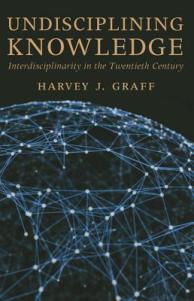
Undisciplining Knowledge: Interdisciplinarity in the Twentieth Century, Harvey J. Graff. Baltimore, MD: Johns Hopkins University Press, 2015.
Summary: This is a historical study of interdisciplinary efforts in universities, looking at successive efforts in the twentieth century and considering the location of such “interdisciplines”, the relationships between disciplines, and the organization of interdisciplinary efforts.
There are two seemingly conflicting conversations consistently occurring in universities. One bemoans the insularity of disciplines, the increasing specialization and formation of sub-disciplines and academic “silos” and the ongoing turf wars of academia. Some seek to hearken back to some “golden age” where there was a unity of knowledge, hence the term “university”. The other advocates for interdisciplinary learning and research efforts as key to breakthroughs in research and uncovering “new knowledge.” Various research centers and collaborations are formed between departments with the hope of innovation, attracting research funding, and enhancing the reputation of one’s institution.
Harvey J. Graff, Director of Literacy Studies@OSU (The Ohio State University), with appointments in both English and History departments, is perhaps uniquely qualified to write this comparative and critical history of interdisciplinary efforts in the university context during the twentieth century. His approach in this book is to compile a series of “case histories” of interdisciplinary efforts arranged chronologically and paired in chapters for comparative purposes. After an introductory chapter on the problem of interdisciplinarity in theory and practice over time, he considers the following pairs of interdisciplinary efforts: genetic biology and sociology, the humanities and communication, social relations and operations research, cognitive science and new histories, materials science and cultural studies, and bioscience and literacy studies. Pairing very different interdisciplinary efforts and the breadth of the case histories across so many interdisciplinary efforts makes this a great entree’ into this discussion
He considers in the history of each of these interdisciplinary efforts the challenges of “location” of such efforts within the disciplinary landscape of academia and particular institutions; the “relationship” of the inter-discipline to its constituent disciplines, sometimes productive and sometimes contentious, and the organization of interdisciplinary efforts. In some cases, such as sociology, what begins as an interdisciplinary effort becomes a discipline. In others, such as social relations, the efforts to form an inter-discipline out of what seem related fields dies because this idealized effort fails to find research efforts that truly bring the related disciplines together coherently. I found the areas of operations research and materials science particularly interesting because these interdisciplinary efforts coalesced around practical research problems. Yet the question arises whether these are true “inter-disciplines” or simply very successful interdisciplinary collaborations. Then there is the example of cognitive science on the one hand with an exceedingly expansive vision that includes everything from philosophy to artificial intelligence, and the “new histories” which seems more like a collection of ever more specific sub-disciplines gathered under the Social Science History Association, than a true inter-discipline (a judgment at variance with the author’s much more favorable assessment).
One very practical observation for those preparing for academic careers is to do this within a discipline. Those pursuing interdisciplinary Ph.D’s tend to earn less and have even greater difficulties finding positions in an already difficult market. And this raises the question in our increasingly monetized universities of whether interdisciplinary efforts can survive unless there is a strong military, governmental or commercial interest driving particular forms of interdisciplinary research. It would seem that this would place an emphasis less on formal organization or an architecture of knowledge than on entrepreneurial collaboration. At the same time, it seems that some efforts like the author’s work in Literacy Studies@OSU, succeed largely through the involvement of affiliate faculty working within a variety of established disciplines.
This is an important work for those working within academia that uncovers both the potential and the pitfalls of interdisciplinary efforts. I would contend this ought to be a “must read” for anyone embarking on such efforts, as well as for those leading academic associations of an interdisciplinary character. There is a significant history from which academic professionals can learn and Graff has done us a great service in compiling this in a single volume.
Editor’s Note: Thank-you to Bob Trube for sharing his reviews with Emerging Scholars! Bob first posted the above review on Bob on Books. For additional Emerging Scholars Network (ESN) blog posts exploring the purpose of education, with a focus on higher education/the university, click here. As you have material to add to this conversation from the lens of a Christian in higher education, comment below and/or contact ESN with a proposal to post on the blog. ~ Thomas B. Grosh IV, Associate Director, Emerging Scholars Network
Bob Trube is Associate Director of Faculty Ministry and Director of the Emerging Scholars Network. He blogs on books regularly at bobonbooks.com. He resides in Columbus, Ohio, with Marilyn and enjoys reading, gardening, choral singing, and plein air painting.

Leave a Reply